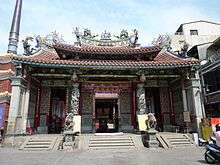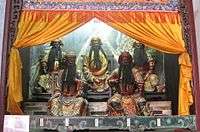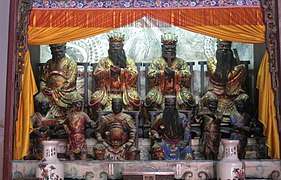Grand Matsu Temple
The Grand Matsu Temple,[1] also known as the Datianhou or Great Queen of Heaven Temple,[2] is a temple to the Chinese sea goddess Mazu, the deified form of the medieval Fujianese shamaness Lin Moniang, located in the West Central District of Tainan on Taiwan.
| Grand Matsu Temple | |
|---|---|
大天后宮 | |
 | |
| Religion | |
| Affiliation | Taoism |
| Deity | Mazu |
| Location | |
| Location | West Central, Tainan, Taiwan |
| Architecture | |
| Type | Temple |
| Creator | Zheng Jing |
| Completed | 1664 |
It is open seven days a week, with free admission.[3]
History
The Grand Matsu Temple was originally the palace of the Southern Ming prince Zhu Shugui, constructed for him near Chikan Tower by the Tungning king Zheng Jing[4] in 1664.[5]
Zhu, known as Prince Ningjing, helped Koxinga's dynasty colonize and clear farmland in the surrounding Chengtian Prefecture but, after Shi Lang's 1683 victory at Penghu, Zheng Keshuang was obliged to surrender to the Qing Empire. Zhu's five concubines then hanged themselves one by one from the beams of his palace's bedroom and the next day he joined them in suicide. His ladies continue to be honored at Tainan's Five Concubines Temple.[4][6]
Shi Lang initially took up residence at the palace, rebuilding some areas to his liking, but then memorialized the Kangxi Emperor to convert it into a temple to Mazu,[7] the deified form of the medieval Fujianese shamaness Lin Moniang. This was done the next year in 1684[8] under Mazu's newly-granted title of "Empress of Heaven". It was the first temple to be so named, giving it some precedence over her earlier temples, which honored her as a "Princess of Heaven".[7] The move served a propaganda function, with the Qing claiming to honor Mazu's "support" for their conquest of Taiwan from Tungning.[4]
The temple was renovated in 1765 and again in 1775, when it assumed its current appearance.[7] A fire occasioned another rebuilding in 1818 and it fell into disrepair in the late Qing. Following the Japanese occupation of Taiwan, it was almost auctioned to private interests but this was cancelled at the last minute. It was partially rebuilt after damage from an earthquake in 1946.[7]
The temple was declared a protected monument in 1985.[4]
Architecture
The Main Hall is dedicated to Mazu, flanked by her two guardian demons Qianliyan and Shunfeng'er.[7] It includes a stele erected by Shi Lang in 1685.[5] The Rear Hall is also known as the Sacred Parents Hall, as it honors Mazu's parents, along with her brother, sisters, and the Prince of Ningjing. It is the site of the prince's former bedroom, where his five concubines preceded him in suicide during the Qing conquest of Taiwan.[7]
Services
The altar of Yue Lao, the old man under the moon, is frequented by singles in search of a husband or wife.[2]
Legacy
The temple is the namesake of West Central District's surrounding Tienhou Community.[9]
Gallery
- Entrance plaque
 The Five Kings of the Water Immortals
The Five Kings of the Water Immortals The Dragon Kings of the Four Seas
The Dragon Kings of the Four Seas- Incense burner
- Main Hall in the evening
See also
References
- Official site, Tainan: Grand Matsu Temple, 2007. (in Chinese) & (in English)
- "Great Queen of Heaven Temple", Official site, Taipei: Tourism Bureau of the Republic of China, 2015.
- "Grand Mazu Temple", Official site, Tainan: Tourism Bureau of the Tainan City Government.
- "Tainan Grand Matsu Temple", Chinatownology, 2015
- Keeling, Stephen (2013), "Datianhou Temple", The Rough Guide to Taiwan, Rough Guides.
- Bates, Roy (2007). 10,000 Chinese Numbers. China History Press. p. 130. ISBN 9780557006212.
- Bergman, Karl (2009), "Tainan Grand Matsu Temple", Tainan City Guide, Tainan: Word Press.
- Zhang Yunshu (2013), A Study of Mazuism in Tainan [臺南媽祖信仰研究, Tainan Mazu Xinyang Yanjiu], Tainan: Tainan Cultural Bureau, p. 64, ISBN 978-986-03-9415-3. (in Chinese)
- Shao Pei-chun (2017), "Risk Communication Applied to Community-Based Fire Mitigation and Management for Historic Areas", Fire Science and Technology 2015: The Proceedings of the 10th Asia-Oceania Symposium on Fire Science and Technology, Singapore: Springer, p. 385.
External links
| Wikimedia Commons has media related to Tainan Grand Matsu Temple. |
- Official site. (in Chinese) & (in English)